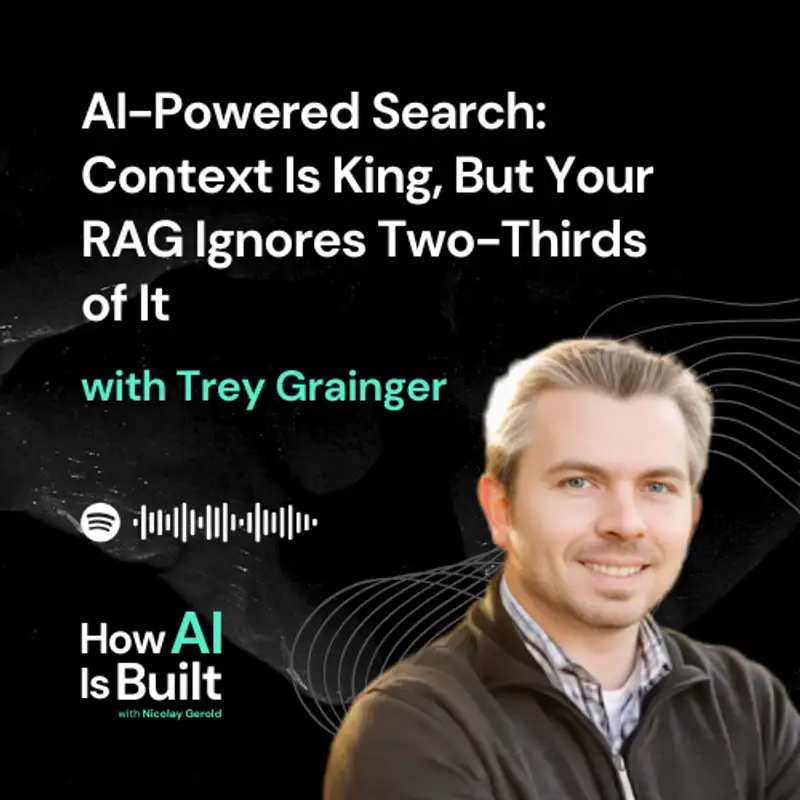Today, I (Nicolay Gerold) sit down with Trey Grainger, author of the book AI-Powered Search. We discuss the different techniques for search and recommendations and how to combine them.
While RAG (Retrieval-Augmented Generation) has become a buzzword in AI, Trey argues that the current understanding of "RAG" is overly simplified – it's actually a bidirectional process he calls "GARRAG," where retrieval and generation continuously enhance each other.
Trey uses a three context framework for search architecture:
- Content Context: Traditional document understanding and retrieval
- User Context: Behavioral signals driving personalization and recommendations
- Domain Context: Knowledge graphs and semantic understanding
Trey shares insights on:
- Why collecting and properly using user behavior signals is crucial yet often overlooked
- How to implement "light touch" personalization without trapping users in filter bubbles
- The evolution from simple vector similarity to sophisticated late interaction models
- Why treating search as a non-linear pipeline with feedback loops leads to better results
For engineers building search systems, Trey offers practical advice on choosing the right tools and techniques, from traditional search engines like Solr and Elasticsearch to modern approaches like ColBERT.
Also how to layer different techniques to make search tunable and debuggable.
Quotes:
- "I think of whether it's search or generative AI, I think of all of these systems as nonlinear pipelines."
- "The reason we use retrieval when we're working with generative AI is because A generative AI model these LLMs will take your query, your request, whatever you're asking for. They will then try to interpret them and without access to up to date information, without access to correct information, they will generate a response from their highly compressed understanding of the world. And so we use retrieval to augment them with information."
- "I think the misconception is that, oh, hey, for RAG I can just, plug in a vector database and a couple of libraries and, a day or two later everything's magically working and I'm off to solve the next problem. Because search and information retrieval is one of those problems that you never really solve. You get it, good enough and quit, or you find so much value in it, you just continue investing to constantly make it better."
- "To me, they're, search and recommendations are fundamentally the same problem. They're just using different contexts."
- "Anytime you're building a search system, whether it's traditional search, whether it's RAG for generative AI, you need to have all three of those contexts in order to effectively get the most relevant results to solve solve the problem."
- "There's no better way to make your users really angry with you than to stick them in a bucket and get them stuck in that bucket, which is not their actual intent."
Trey Grainger:
Nicolay Gerold:
00:00 Introduction to Search Challenges
00:50 Layered Approach to Ranking
01:00 Personalization and Signal Boosting
02:25 Broader Principles in Software Engineering
02:51 Interview with Trey Greinger
03:32 Understanding RAG and Retrieval
04:35 Nonlinear Pipelines in Search
06:01 Generative AI and Retrieval
08:10 Search Renaissance and AI
10:27 Misconceptions in AI-Powered Search
18:12 Search vs. Recommendation Systems
22:26 Three Buckets of Relevance
38:19 Traditional Learning to Rank
39:11 Semantic Relevance and User Behavior
39:53 Layered Ranking Algorithms
41:40 Personalization in Search
43:44 Technological Setup for Query Understanding
48:21 Personalization and User Behavior Vectors
52:10 Choosing the Right Search Engine
56:35 Future of AI-Powered Search
01:00:48 Building Effective Search Applications
01:06:50 Three Critical Context Frameworks
01:12:08 Modern Search Systems and Contextual Understanding
01:13:37 Conclusion and Recommendations
 S2E21
S2E21